Gold Briefly Dips As Risk Aversion Fades on Israel-Iran Ceasefire, China Trade Deal
Posted onGold briefly slipped to a four-week low as some investors rotated back toward riskier assets, such as stocks, following the Israel-Iran ceasefire deal, which appears to be holding for now. Stocks climbed after President Trump said a trade deal had been signed with China, as Beijing agreed to approve rare earth exports.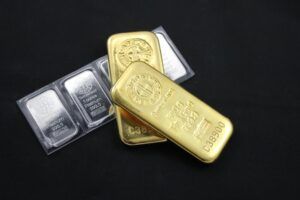
Investors and traders had piled into the safety of precious metals as missiles flew in the Middle East and amid concerns that trade was slowing between the world’s two largest economies. The ceasefire and trade deal alleviated some of the market’s most pressing geopolitical and economic concerns, prompting light profit-taking in gold.
Gold slid below $3,300 an ounce as short-term traders took profits on the recent double-digit rally in precious metals. The long-term trend remains positive for gold, and the metal remains well above its 200-day moving average, a technical signal that confirms the uptrend remains in place.
Gold and Silver Remain the Best Performing Asset Class in 2025
Even with the light pullback in gold prices, the precious metal is still notching a 21% gain since the start of the year, with silver up 20%, both handily beating the 4.41% gain in the S&P 500 this year.
Key Inflation Gauge Ticks Modestly Higher
The Federal Reserve’s preferred inflation indicator, the personal consumption expenditure (PCE), rose by 2.3% over the 12 months through May, the Commerce Department said. Excluding food and energy, core PCE inflation rose to 2.7% in May, from 2.6% in April. While the uptick in inflation is positive for the precious metals sector, gold and silver showed little reaction as the easing of the Middle East conflict, for now, has dampened fresh demand for precious metals.
Consumer Spending Drops for the First Time in 2025
Americans spent less in May on both goods and services as consumer spending fell 0.1%. Economists had expected consumer spending to gain 0.1% last month. Consumers bought fewer cars and spent less at restaurants and hotels.
Economists say that consumer worries about tariff hikes translated into weaker spending in the second quarter, which could have a broader impact throughout the year. Consumer spending is a major driver of the American economy, accounting for over two-thirds of all economic activity.
The Bottom Line
The price pullback in gold offers long-term investors an opportunity to accumulate precious metal at lower prices. Now is an opportune time to trade fewer of your dollars for more gold. A number of major Wall Street firms target gains to the $4,000 area and beyond in the months and years ahead. Today’s pricing on gold offers long-term investors an opportunity to increase their allocation to the safety and security of precious metals while they are effectively on sale. Use the summer complacency as your opportunity to make savvy market moves.
Photo by Zlaťáky.cz on Unsplash
Mid-Year Precious Metals Market Update
Posted onWith a heat dome spreading across much of America this summer, it evokes images of kids running through sprinklers, days at the neighborhood pool, backyard barbecues, and fireflies at dusk. As we hit the halfway mark of 2025, it’s an opportune time to check in on the financial markets, key drivers for precious metals performance, and your portfolio.
The first six months of 2025 have been a whirlwind, marked by a fast-paced news cycle that began with the Inauguration of President Donald Trump for his second term in late January. So much has happened that we couldn’t possibly cover it all here, but we’ll touch on key developments impacting the precious metals and stock markets in the first half of the year.
Market Performance Since the Start of 2025
Gold +23%
Platinum +45%
Silver +21%
S&P +3.55%
International Stocks: MSCI ACWI ex-USA Index +16.28%
1-month Treasury Note Yield: 4.21%
5-year Treasury Note Yield: 3.84%
30-year Fixed Mortgage Rate: 6.82%
A few things jump right out.
- Precious metals are the best-performing asset class in 2025. Gold rocketed to a new record high above $3,400 an ounce in April and is trading quietly this summer above the $3,300 level.
- Foreign stocks are outperforming U.S. stocks by a significant amount.
- Mortgage rates remain higher than the low rates of the pandemic and the 2020-2021 era. In January 2021, 30-year mortgages hit a low at 2.65%. The high rates have priced many homebuyers out of the market for now.
The Big Picture
Liberation Day tariffs, geopolitical wars, a U.S. debt downgrade, and climbing national debt have been strong headwinds for the U.S. stock market this year and positive for precious metals. Investors flocked to the safety and security of gold, platinum, and silver amid the mounting uncertainties on many fronts, both military and economic.
Geopolitics Sends Investors Rushing to Precious Metals
Military action ramped up in June as the United States joined Israel with Operation Midnight Hammer, which involved U.S. Air Force B-2 stealth bombers dropping so-called “bunker buster” bombs on an Iranian nuclear site. Israel continues its war against Hamas in the Gaza Strip, and Russia continues its war in Ukraine.
While gold generally led the precious metals complex higher in the first half of the year, in June, both silver and platinum vaulted sharply higher. Precious metals investors saw opportunities to accumulate precious metals at bargain prices, and they swooped in. Silver climbed to a 13-year high, above the $37 an ounce level, while platinum climbed to $1,363.
Tariff Uncertainty
The stock market is eyeing a July 8 tariff deadline, which ends the 90-day pause on most of the steep Liberation Day tariffs if trade deals haven’t been set. Tariffs could climb as high as 50% against some nations. While the Administration is said to be negotiating with China, the European Union, Canada, Mexico, and more, only one trade deal has been finalized thus far, and that is with the United Kingdom. Investors flooded into precious metals throughout the spring months as uncertainty over the impact of tariffs on the economy sent stocks spiraling lower.
America Lost Its Last “AAA” Credit Rating Due to Rising Debt
In May, Moody’s stripped the United States of its last “AAA” credit rating. This was another warning signal that Washington D.C. policymakers have failed to address the unsustainable government debt problem our nation faces. Global investors fear that America is getting close to a point where our debt isn’t affordable anymore.
The news underscored the stability and security of gold in a world racked with government debt. For gold investors, this confirms that gold is in a long-term structural bull market. Analysts at JP Morgan issued a new research note in late spring outlining a scenario that could take gold 80% higher to $6,000 by 2029. They said this could occur if just 0.5% of U.S. assets held by foreign investors were reallocated to gold. Weak demand at Treasury auctions this spring already revealed tepid demand from foreign investors to buy new Treasuries.
Recommendations for Precious Metals Investors
In the dog days of summer, financial markets are relatively stable and quiet, for now. That makes it the perfect time to re-evaluate your portfolio, your asset allocations, and how much wealth protection you need for what may lie ahead. It’s a perfect time to trim your allocation to the stock market and funnel those funds to the safety of physical gold, silver, and platinum.
There is a step you can take to protect, preserve, and even grow your wealth, and that is to increase your allocation to physical gold.
If you aren’t sure what the appropriate amount is for your risk tolerance level, our Blanchard portfolio managers are here to help. Give us a call today at 1-800-880-4653 for a complimentary portfolio review with personalized recommendations to help you protect and grow your wealth. Precious metals are beating everything right now. We are in the midst of a historic gold run. Gold $4,000 will be here faster than you think, and once markets start moving again, you’ll have missed the chance to accumulate physical gold below $3,400 an ounce. It’s easy to add more wealth protection to your life. Why not call us today?
Lesher Colorado Dollars: An Intriguing Chapter in Private Mint History
Posted onIn the 1870’s in Colorado, the discovery of huge amounts of silver ore in the mountains triggered a massive silver boom. Silver mining expanded significantly in the state over the next decade, and Leadville became known as the “Silver Capital of America.” Colorado mountain towns saw explosive population growth and prosperity driven by mining.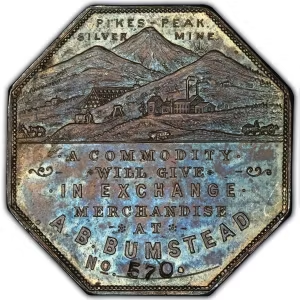
However, the silver boom period slid into a bust. Changes to the global international monetary systems relating to precious metals triggered a collapse in the price of silver, which directly impacted the Colorado silver mining towns.
In the 1870s, many countries, including Holland, France, Belgium, Italy, Switzerland, and Greece, stopped minting silver coins. The United States, which had been minting silver dollars, joined those countries and went on the gold standard. The amount of silver coined internationally dropped 50% in just two years. This led to a silver price collapse at a time when production was increasingly dramatically in Colorado.
Joseph Lesher, a successful Colorado miner turned mine owner, wanted to revive the local economy after the silver price decline dragged down growth. Lesher was a passionate advocate of the “Free Silver” movement, which advocated for the unlimited coinage of silver in America to expand the money supply and stimulate the economy.
Lesher took action. He started a private mint and struck octagonal silver coins—known as Lesher Referendum dollars in 1900 and 1901. These coins were intended to circulate locally and stimulate demand for silver, thereby helping to reopen idle mines and restore prosperity to the region.
Lesher’s minting operation was short-lived, running from late 1900 through 1901. During this period, he produced an estimated 2,000 to 3,000 pieces in total.
The fascinating design of many Lesher dollars reveals their important connection to Colorado’s silver mining boom era. Some Lesher Dollars feature a magnificent depiction of Pikes Peak, the iconic Colorado Mountain. The mountain’s image symbolized the region’s mining heritage and the aspirations of those who sought fortune in its shadow. Alongside Pikes Peak, the coins often bore inscriptions such as “JOS. LESHERS REFERENDUM SILVER SOUVENIR MEDAL,” the year of issue, and the name of the merchant or town that accepted the coin as currency.
Lesher Dollars are immediately recognizable by their distinctive octagonal shape and large size. The coins were hand-punched, resulting in unique variations and individual quirks for each piece. Today, Lesher Dollars are extremely rare, with just over 20 different types identified by PCGS. They are differentiated by the names of Colorado merchants and towns stamped on them. Some varieties are known by only a single surviving specimen. Their scarcity and historical importance make them highly sought after by collectors today.
Gold Leaps Over Euro to Become Second Largest Central Bank Reserve Asset
Posted onIt’s no secret that global central banks have been stockpiling gold. But we just didn’t know how significant the central bank gold buying has been. Demand for gold bullion is so strong that the precious metal has surpassed the euro to become the second-largest asset held by central banks around the world.
For the last three years, global central banks have bought more than 1,000 tons of gold each year. Because of all that gold buying, today, gold is the world’s second-largest global central bank reserve asset, behind the U.S. dollar.
Gold pushed past the euro in 2024, taking second place, according to new data from the European Central Bank. Here’s the breakdown.
Global Central Bank Reserves
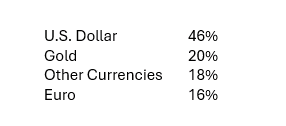
Source: European Central Bank, International Monetary Fund, Bloomberg
At the end of 2024, global central bank holdings of gold had climbed to around 36,000 tons, near the all-time high of 38,000 tons set in 1965.
Why are central banks buying gold? It’s simple. It turns out that central banks are buying gold for many of the same reasons that individual investors are piling into the precious metal.
Central banks are buying gold for diversification purposes and also to hedge against geopolitical risk, the European Central Bank report said. Reserve managers also value gold as a portfolio diversifier to hedge against inflation, cyclical downturns, and defaults.
Why does this matter to you? Central banks are long-term investors. They see value in gold at current levels and continue to buy and stockpile the precious metals in their global central bank vaults. If they are increasing their exposure to gold, maybe you should consider it too.
It’s been an epic rally in gold, and precious metals are still climbing.
The price of gold has climbed nearly 62% since the beginning of 2024. Silver is soaring too. Silver just jumped past $36.00 an ounce, and analysts are now pointing to $40 as the next big target. Platinum is also rocketing higher, climbing 35% since the start of the year. In fact, platinum, gold, and silver are the top three best-performing assets of 2025. Precious metals are in a strong uptrend, with huge momentum and are still climbing. A number of Wall Street forecasts point to gold at $4,000 an ounce and beyond.
For centuries, people have turned to precious metals as a store of value and as an asset to protect and grow their wealth. If you’ve been thinking about increasing your allocation to precious metals, don’t wait; the markets are moving, and gold at $4,000 will be here before you know it.
One of America’s Greatest Unsolved Mysteries: The Lost Colony of Roanoke Island
Posted onThe enduring story of the Lost Colony of Roanoke Island remains one of the biggest mysteries in American history. Established in the late 1500s on Roanoke Island, present-day North Carolina, the colony was England’s first attempt to establish a settlement in the New World.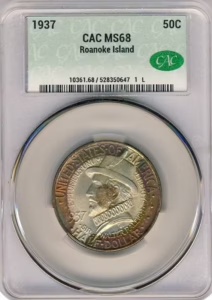
Yet, one day, the entire colony disappeared without a trace.
The unsettling disappearance of the entire colony triggered centuries of speculation, theories, and many investigations. None of these ideas has ever borne fruit and explained what really happened to these 120 brave English souls who traveled to the New World, but then disappeared.
A Coin to Remember It
The mystery and intrigue surrounding the lost colony have turned the 1937 Roanoke silver half-dollar commemorative coin into one of the most popular commemorative coins in American numismatics. After all, it represents a foundational episode in our nation’s history. For those who haven’t heard the story before, here are some of the basic facts that we do know to be true.
Setting Sail for the New World
In the late 1500s, there was a fierce competition among European powers to establish overseas colonies. The Roanoke exploration and colony were primarily financed by Sir Walter Raleigh, an ambitious Englishman. In 1584, Queen Elizabeth I granted Raleigh the right to explore and colonize lands not already claimed by Christian monarchs. Raleigh invested heavily in this venture, seeking both personal gain and national glory. The initial 1584 reconnaissance voyage reported abundant natural resources and friendly native populations, fueling hopes for a prosperous settlement.
In 1587, families including women and children joined the 1587 expedition to Roanoke Island led by John White, with the goal of building a permanent community in the New World. On August 18, 1587, White’s daughter Eleanor Dare gave birth to a daughter, Virginia Dare, who was the first English child born in a New World English colony. Her legacy endures today in American history.
When John White returned to Roanoke in 1590 after a three-year absence, he found the entire colony gone. The only clues he could find were the word “CROATOAN” carved into a post and “CRO” on a tree. The fate of the roughly 120 colonists, including his granddaughter, remains unknown to this day.
What Could Have Happened to the Roanoke Colonists?
- One of the most popular theories is that the British colonists sought refuge with friendly native peoples, such as the Croatan (now Hatteras) tribe. Perhaps they married into and assimilated into their native communities.
- Some believe the entire Roanoke colony perished due to food shortages, hostile conflicts with native tribes, or that disease spread and took the entire settlement out.
- Other historians have argued that the Roanoke colonists moved to another location, but no definitive archaeological evidence has been found.
- Another theory that has been put forth is that the Spanish forces destroyed the colony, since Spain and England were warring at that time.
Despite many archeological digs, the fate of the Lost Colony remains a mystery today.
What we do know is that the Colony of Roanoke Island is historically significant as it marked the first English effort to establish a permanent settlement in North America. And the brave souls who journeyed across the ocean gave their lives for a bigger cause.
Honoring the Lost Colony: A Special Coin
In 1937, to mark the 350th anniversary of the Roanoke Colony and the birth of Virginia Dare, the United States Mint issued a special silver commemorative half dollar. Congress authorized this coin to celebrate both the historical significance of the colony and the enduring mystery surrounding its fate.
Why Collectors Prize the Roanoke Island commemorative half dollar
This visually stunning coin commemorates a truly remarkable event in American colonial history, steeped in mystery and intrigue as well as historical significance.
The artistry of this coin will never be forgotten once you have seen it. Experts agree that the detailed and symbolic imagery on the coin makes it a standout among commemorative issues.
The obverse of the silver coin features Sir Walter Raleigh in period dress, shining a light on his role as the colony’s sponsor and visionary. The inscription includes “United States of America,” “Half Dollar,” and “Sir Walter Raleigh.”
The reverse of the coin portrays a dramatic image of Eleanor Dare holding her baby daughter, Virginia Dare, against the backdrop of a coastal landscape. This scene pays tribute to the first English child born in America and the families who braved the unknown.
In Memory…
The Lost Colony of Roanoke Island remains an enigma, a story of adventure and adversity at the dawn of English America. Its legacy is preserved in the form of a beautiful silver commemorative coin. The coin is a tangible reminder of both the optimism, bravery, and tragedy of the Roanoke colonists and is a prized numismatic gem for collectors and historians alike. Curious? Blanchard has one of these historical gems on offer now. See it here.
Economic Data Shows Cracks in Growth Picture. Gold Up 22% YTD
Posted onThere are growing signs the U.S. economy has entered a slow patch in the first half of the year. From a negative growth reading in the first quarter to a sharp increase in Americans collecting unemployment checks, uncertainty about what lies ahead is showing up in the data. In the midst of it all, gold is the top-performing asset of the year with a 22% year-to-date gain.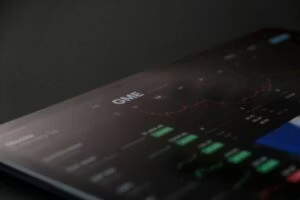
The case for gold ownership remains strong, and in a late May report, Goldman Sachs urged investors to buy gold and oil to reduce portfolio risk. “Following the recent failure of U.S. bonds to protect against equity downside and the rapid rise in U.S. borrowing costs, investors seek protection for equity-bond portfolios. During any 12 months when real returns were negative for both stocks and bonds, either oil or gold have delivered positive real returns,” Goldman said.
Let’s dive into the economic picture.
Gross Domestic Product (GDP) Growth
In the first quarter of 2025, the U.S. economy went into reverse. After growing in 2024, economic growth turned negative in the first three months of 2025, shrinking by 0.2%, the Bureau of Economic Analysis said in its revision to the government data. Slowing consumer spending, a downturn in government spending, and an 11.3% decline in corporate profits were to blame. With profits slowing, there is probably little incentive for businesses to boost hiring.
Americans Collecting Unemployment Checks Hit 3 1/2 Year High
The number of Americans filing new applications for jobless benefits increased more than expected in late May. Initial claims for state unemployment benefits rose 14,000 to 240,000 for the week ended May 24, the Labor Department said. The number of Americans collecting unemployment checks in mid-May hit the largest number in 3 1/2 years.
This raises the risk that the overall unemployment rate could tick up to 4.3% in the May employment report, from 4.2% in April.
Spring Home Sales on Ice
Just as the spring home-selling season is supposed to be kicking into high gear, pending home sales dropped by 6.3% in April, the National Association of Realtors reported. Pending home sales fell in all four U.S. regions, NAR said.
“At this critical stage of the housing market, it is all about mortgage rates,” said NAR Chief Economist Lawrence Yun. Despite an increase in housing inventory, we are not seeing higher home sales. Lower mortgage rates are essential to bring home buyers back into the housing market.”
As of May 29, interest rates for a 30-year fixed-rate mortgage stood at 6.89%, the third weekly increase, according to Freddie Mac.
Next Stop: Gold at $4,000
Amid the signs of economic weakness, investors are turning to the safety of gold. For those investors wondering if it’s too late to buy gold given the big jump already this year, the short answer is no. Gold is in a strong bull market, and precious metals continue to climb. Goldman Sachs targets additional gains in gold prices to the $4,000 area by 2026, but the firm said that even a small move away from the U.S. bond market could drive gold far beyond the $4,000 level. Don’t wait to increase your allocation to gold; make your move today.
Photo by Aidan Tottori on Unsplash
Florida Governor Signs Bill Making Gold and Silver Legal Tender
Posted onThis week, Florida Governor Ron DeSantis signed a bill to begin the process of making gold and silver legal tender in that state. Why? “This is our ability to give you the financial freedom to be able to protect yourself against the declining value of the dollar,” said DeSantis. The new state law will go into effect July 1, 2026.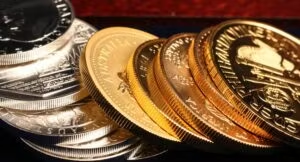
Sound Money Laws Gain Momentum in the States
Florida isn’t alone. There is a growing movement across a number of states to recognize gold and silver as legal tender. As of mid-2025, a number of states have enacted legislation officially recognizing gold and silver coins as legal tender, while many other states have bills up for consideration.
Here are just a few of the states that currently recognize gold and silver coins as legal tender, which allows for these coins to be used for payments of debts and in commerce:
- Utah: The Utah Legal Tender Act, enacted in 2011, recognizes U.S.-mint gold and silver coins as legal tender.
- Louisiana: The state currently has a law on the books stating that gold and silver is legal tender. Currently, there is new legislation that proposes a modification to the language to state that any gold or silver coin, specie, or bullion must be recognized by the U.S. government, rather than issued by it, to be considered legal tender in the state. This modification replaces the term “issued” with “recognized” and removes the requirement for state issuance.
- Oklahoma: In 2014, the Oklahoma Senate Bill 862 recognized gold and silver U.S.-minted coins as legal tender and exempt from taxation.
- Wyoming: In 2018, Wyoming established a law that eliminated the taxation of gold and silver bullion.
- South Carolina: In 2013, the South Carolina House of Representatives passed a bill declaring gold and silver legal tender.
- Kansas: In 2013, the Kansas Committee on Taxation passed a bill declaring U.S.-minted coins as both of legal tender and tax-exempt.
A Constitutional Foundation for Gold and Silver as Money
Why is this movement growing across our nation today? Supporters of sound money point to the U.S. Constitution’s specific reference to gold and silver as money, arguing that returning to these standards upholds the nation’s founding legal framework.
The U.S. Constitution in Article 1, Section 10, says: “No State shall… make any Thing but gold and silver Coin a Tender in Payment of Deb
ts.” This clause is often cited by sound money advocates as the constitutional basis for states to recognize precious metals as money.
While, federal policy has favored the use of paper currency, states do have the authority to recognize gold and silver as legal tender within their own jurisdictions.
Other Reasons State Legislatures Are Focusing on Gold and Silver
The sound money movement to restore gold and silver as legal tender across states is being driven by a desire for economic stability in a currency. Unlike paper money (fiat currency), which governments and central banks can print in unlimited quantities, gold and silver are naturally scarce. For example, the annual increase in the global gold supply is generally only about 1.4% to 2.2%.
But, the supply of paper money can grow rapidly. During the Global Financial Crisis and the Covid Pandemic, the government printed new paper money to flood the financial system with liquidity. In 2020 alone, U.S. money supply, as measured by M2, grew by 27%.
More supply devalues the purchase power of paper money over time.
Over 5,000 years of history, gold and silver have held and increased in value. Meanwhile, there are numerous examples in history where paper currencies have been devalued, destroyed and made nearly worthless by hyperinflation or monetary policy changes. Precious metals offers a stable store of value and a hedge against currency devaluation.
Proponents of the sound money movement also point to benefits including financial privacy and freedom. Unlike digital payments which are track
ed and can even be frozen by governments, using physical gold and silver can offer privacy and autonomy in financial transactions.
Last but not least, concerns about the rising United States government debt is creating concerns about a potential currency crisis, devaluation or a period of significantly higher inflation in our nation.
The Bottom Line
Gold and silver have served as currencies for over 5,000 years and have stood the test of time. In today’s modern world, investors big and small still put their faith into precious metals. Central banks around the globe have been adding to and stockpiling new gold reserves in recent years at a record pace. It’s not just central bankers. Demand for gold bars and coins has been surging among individual investors too, with some dealers experiencing temporary shortages.
At Blanchard, we are committed to helping you protect and preserve your wealth. We have an extensive inventory of gold and silver bullion available to ship today. It’s easy to increase your wealth protection if you act now. Explore our gold coin or silver coin inventory now.
Want to read more? Subscribe to the Blanchard Newsletter and get our tales from the vault, our favorite stories from around the world and the latest tangible assets news delivered to your inbox weekly.
The 1896 Barber Quarter Proof: A Tangible Connection to the Gilded Age
Posted onThe Barber Quarter is a perennial favorite among collectors for its historical significance and the exciting challenge that comes with trying to assembling a complete set, including coins from all mint facilities.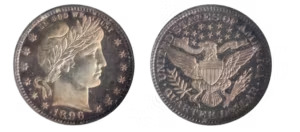
In their era, Barber Quarters primarily went immediately into circulation and stayed there. They were heavily used and today survivors in high grades are scarce. In 1896, a mere 762 Barber proofs were minted. Today, high-quality 1896 Barber proof quarters are hard to come by. There’s only an estimated 250 survivors in grades 65 or better.
To hold a 1896 Barber Quarter in your hand is a direct connection to one of the most economically vibrant periods in our nation’s history. This coin was minted towards the end of the Gilded Age.
The rapid growth of heavy industry, like factories, railroads, and coal mining, drove economic growth forward at a furious pace in these years. The Gilded Age era featured storied wealthy industrialists and financiers like John D. Rockefeller, Andrew Carnegie, J.P. Morgan, and Cornelius Vanderbilt, who are well-remembered today. Many of their Gilded Age fortunes were turned to good use through philanthropy, and they continue to impact people’s lives today through universities, hospitals, museums, and libraries.
Barber quarters were minted from 1892 to 1916. The striking coin is named after its designer, United States Bureau of the Mint Chief Engraver Charles E. Barber. The Barber quarter is part of a series of coins, which today collectors refer to as the “Barber coinage.” This includes a dime, quarter and half dollar.
Today, collectors strive to own a collection of Barber quarters minted at all the different U.S. Mint facilities, including Philadelphia (no mint mark), New Orleans (O mint mark), San Francisco (S mint mark), and Denver (D mint mark).
The Barber quarter was introduced as part of a modernization effort of our nation’s coinage, and it replaced the Seated Liberty quarter, which had been in circulation since 1838. The Barber quarter has earned a revered place in the numismatic world as it represents the changing coinage during the late 19th century.
Minted with 90% silver and 10% copper, the obverse features a bust of Liberty facing right. She wears a Phrygian cap, which is a symbol of freedom, and is surrounded by the words “IN GOD WE TRUST.” The date is located below the bust of Liberty. The reverse highlights a memorable heraldic eagle with outstretched wings. The eagle holds an olive branch and arrows in its talons, symbolizing peace and strength.
This coin was minted during an extraordinary period of American history—the Gilded Age. Other memorable events in 1896: Utah was admitted as the 45th state to the United States of America, in May 1896, a group of 12 industrial stocks was chosen to form the Dow Jones Industrial Average, and in November 1896, Republican William McKinley won the U.S. presidential election, defeating William Jennings Brian. Take a look at the artistry of the 1896 Barber Quarter Proof here and imagine holding it in your hand as a way to connect to this historic time in America.
America Loses Its Last Sterling “AAA” Credit Rating Due to Rising Debt
Posted onAmerica’s credit isn’t as good as it used to be. In a surprise announcement, Moody’s Ratings downgraded the U.S. government’s credit in mid-May. Moody’s Ratings was the last of the three major ratings agency that had given America access to the exclusive Triple-A club. No more.
Moody’s downgraded its credit rating of the United States to “Aa1” from “AAA.” The firm pointed to rising debt and interest “that are significantly higher than similarly rated sovereigns.”
“Successive U.S. administrations and Congress have failed to agree on measures to reverse the trend of large annual fiscal deficits and growing interest costs,” Moody’s said. “We do not believe that material multi-year reductions in mandatory spending and deficits will result from current fiscal proposals under consideration.”
What Is a Credit Rating?
When you apply for a new credit card, the financial institution looks at your credit score. For a nation, a credit rating is an assessment of the government’s ability to repay its debt, like the Treasury bonds and notes that it sells.
The highest rating is AAA, and then ratings move lower indicating default risk from AA to BBB to C and lower. For governments, a high credit rating signals strong fiscal health and a high likelihood of repaying debts on time, while a lower rating suggests increased risk for lenders and investors.
Why Does the U.S. Credit Rating Matter?
The U.S. credit rating is important because it directly impacts the cost of borrowing for the government. When our nation carried an AAA rating, it could borrow money at the lowest possible interest rates, as investors saw our debt as virtually risk-free.
A downgrade signals to investors that lending to the U.S. is slightly riskier, prompting them to demand higher interest rates to compensate for that risk.
Bottom line? A lower credit rating means higher borrowing costs when the U.S. government auctions off Treasury bond and notes to pay our national debt. This can also lead to higher borrowing costs for consumers since U.S. Treasury yields serve as a benchmark for many other interest rates throughout the economy.
What Does a Downgraded Credit Rating Mean for the U.S. Economy and You
Looking ahead, this news could have real-life consequences for our government and everyday Americans including:
Higher Borrowing Costs: The U.S. government may have to pay more to borrow money, which can increase the federal deficit over time
Rising Interest Rates: As Treasury yields rise, so do rates on mortgages, auto loans, and corporate debt, making borrowing more expensive for households and businesses
Market Volatility: Downgrades can unsettle financial markets, causing volatility in stocks, bonds, and currencies as investors reassess risk
The 2011 U.S. Credit Downgrade and Its Impact on Gold
Looking back, the first-ever downgrade of the US credit rating occurred in August 2011, when Standard & Poor’s lowered the U.S. from AAA to AA+
This downgrade unfolded amid intense political standoffs in Congress over the U.S. debt ceiling and sent shockwaves through the stock market and gold soared to record highs. Investors turned to the safety of gold as the U.S. government’s credit-worthiness was questioned, which led to bigger questions about the stability of the U.S. financial system.
What Could the Latest Downgrade Mean for Gold Now?
In August 2023, Fitch lowered its US credit rating from AAA to AA+. And, now Moody’s has also lowered theirs. The news underscores the stability and security of gold in a world racked with government debt.
For gold investors, this helps underscore that gold is in a structural bull market. Analysts at JP Morgan issued a new research note in mid-May outlining a scenario that could take gold 80% higher to $6,000 by 2029. They said this could occur if just 0.5% of U.S. assets held by foreign investors was reallocated gold.
Do You Own Enough?
Never before in history has there been such a strong case for gold ownership. With rising government debt, political brinksmanship, and concerns about fiscal sustainability, gold acts as a safe haven, a store of value and a vehicle to grow your wealth. It’s easy to increase your wealth protection with an increased allocation to gold. Why not do it today?
Want to read more? Subscribe to the Blanchard Newsletter and get our tales from the vault, our favorite stories from around the world and the latest tangible assets news delivered to your inbox weekly.
1915-S Panama Pacific Coins Celebrate One of the Greatest Engineering Feats in History
Posted onThe opening of the Panama Canal in 1914 represented one of the greatest engineering feats in the history of the world at that time. Throughout the 1800s,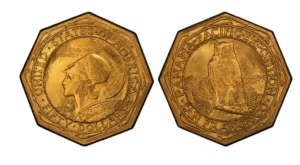 businessmen around the globe wanted to ship goods quickly and cheaply between the Atlantic and Pacific coasts—and the long-awaited opening of the Panama Canal transformed global trade.
businessmen around the globe wanted to ship goods quickly and cheaply between the Atlantic and Pacific coasts—and the long-awaited opening of the Panama Canal transformed global trade.
It had been a long time coming. In 1881, the French tried, and failed, to build a pathway to connect the Atlantic and Pacific oceans. When the United States took it over in 1904 and took the project to completion in 1914, it cemented the technological prowess and growing influence of America on the world stage.
In January 1915, Congress authorized the production of five commemorative coins for the Panama-Pacific International Exposition, to be held that year in San Francisco. The legislation authorized a silver half dollar, a gold dollar, a gold $2.50, and two $50 gold pieces (one round and one octagonal). The octagonal version was the first and only time that the U.S. Mint produced a non-round coin.
The U.S. Mint, however, faced challenges during the production of the 1915-S Panama-Pacific coins. First, there was the tight timeline. The authorizing legislation for the coins was passed in early January 1915, yet the Panama-Pacific International Exposition opened on February 20, 1915!
The law required coins to be ready by the exposition’s opening, which proved impractical due to the short time frame between the law’s passage and the fair’s start. The Mint tried to act quickly, but coins were not available for sale at the opening of the exposition.
Then there was also the mint mark controversy. A major production hiccup emerged when the first dies for the gold dollar and half dollar arrived at the San Francisco Mint without the customary “S” mint mark!
The Philadelphia Mint Superintendent had thought the mint mark was unnecessary since all coins were being struck in San Francisco, but Mint Director Robert W. Woolley disagreed, fearing confusion with Philadelphia issues and local backlash. As a result, all dies had to be returned to Philadelphia for reworking to include the mint mark, which caused even more delays.
Today, the 1915-S Panama–Pacific commemorative coins are among the most storied and sought-after issues in American numismatics, in part due to the remarkable achievements they commemorate.
Between February and December 1915, over 18 million people from around the world visited the Panama-Pacific International Exposition, which sat on over 600 acres in San Francisco’s Marina District.
The Exposition celebrated the completion of the Panama Canal, and also showcased San Francisco’s remarkable recovery from the devastating 1906 earthquake and fire. The World Fair also promoted technological and motor advancements, including a demonstration of a transcontinental telephone call, and events to promote the use of automobiles.
Minted to celebrate a pivotal moment in U.S. history, these coins embody both artistic achievement and historical significance. Charles Keck designed the 1915-S Panama-Pacific $1 gold coin. The obverse features the head of a man representing a Columbian laborer. On the reverse, two dolphins encircle ONE DOLLAR.
Charles E. Barber designed the 50c silver commemorative, which showcases Lady Liberty scattering flowers on the obverse and an eagle perched on a Union shield on the reverse.
The 1915-S Panama-Pacific commemorative coins are enduring symbols of American engineering prowess and resilience. Their origins in a world’s fair celebrating the Panama Canal and San Francisco’s rebirth, combined with their low mintage, artistic beauty, and deep historical significance, cemented their place among the most treasured U.S. commemoratives.
Want to read more? Subscribe to the Blanchard Newsletter and get our tales from the vault, our favorite stories from around the world and the latest tangible assets news delivered to your inbox weekly.







